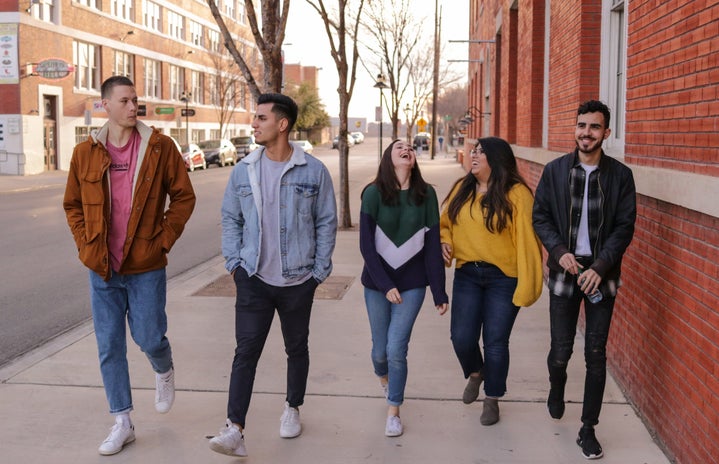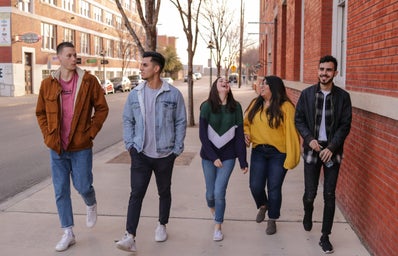Recently, I had the opportunity to conduct an interview with a Kenyon College drama professor who recently directed an original production called Unframed. I was in the process of writing an article about the production for my college newspaper. The day that I interviewed this director, I was feeling a bit despondent. It was just one of those days where, for whatever reason (PMS may have been involved?), I had to keep fighting the urge to cry. Perhaps due to my emotional fragility at the time, my interviewee’s words resonated with me in a deeper place than usual. He spoke of the musicals that he directed, the lyrics and scripts that he wrote, his experience coming to teach at Kenyon for the first time, and the unprecedented intensity that he watched his actors bring to the production. What I found to be so special about Unframed, in particular, is that it is a series of short musicals inspired by visual art in the Gund Gallery. This melding of art worlds brought me right back to a different phase of my life.
I spent grades six to twelve in an arts-centric school in Vancouver, Washington called the Vancouver School of Arts and Academics (VSAA). Seven years is a long time to attend the same school, particularly one with fewer than 600 students total. A lot happens between the ages of eleven and eighteen—puberty, namely. Those are formative years in more ways than I think we typically recognize while we are caught in the midst of them. There were aspects of myself that I knew were changing throughout my teenage years. I felt myself growing more confident, I started listening to different music, wearing different clothes, laughing at different jokes, falling in love with people and places and ideas, enjoying different activities (I do believe I recall a distant time when kissing was gross), and talking about different things (I don’t remember exactly when politics entered the picture, but by the time I was eighteen it dominated most conversations). These were all personal shifts that I observed internally as they were happening, flipping myself inside-out every once in a while and picking apart the pieces that had changed in the process. There were, however, pieces of my personality that developed without my knowledge, submerging into the innermost parts of me with such potent saturation that they have perhaps become irretrievable.
It baffles me now that I did not see art weaving itself into my being as it did. I realized when speaking with the director of Unframed about his artistic experiences, how profound my own have been in shaping me. I recognized for the first time since coming to Kenyon, just how much I miss art. Of course, Kenyon is full of art itself. There are always concerts, plays, musicals, open mics, film showings, and workshops happening on campus. I am a frequent visitor of the Gund Gallery, and I rarely miss a show at the Horn. However, there is a different feeling that comes with being part of a community that is quite literally defined by art. In middle school and high school at VSAA, our student body went by the term “art-schoolers.” As a student there, art was a huge part of my identity. There were murals and art installations adorning every hallway, and even in my academic classes, we were frequently asked to create art projects instead of writing papers. We had access to multiple theaters, paints, canvases, clay, music practice rooms, dance studios, and a darkroom plus materials for developing film. There were pianos in the hallway that students would stop and play in passing time between classes or in the frenzied fifteen minutes before school started as the buses were arriving. There were always people singing, playing guitar, painting, taking photographs and videos around campus, and talking about art. I can’t count the number of lunch conversations I had with my friends centered around Oscar award predictions, the lyrics of songs by The Strokes, or the newest Broadway musical. I’d talk through my story or poem ideas, listen to my friends’ latest musical compositions, look at photos of their half-finished paintings, and watch clips of their dance choreography. Now, in college, the question everybody asks is “What’s your major?” Back then, it was “What’s your art form?” So I don’t just miss art. I miss being completely immersed in it. I miss being surrounded by it constantly, whether I wanted to be or not.
There has recently been a debate surrounding the importance of art in schools. Many public schools are cutting their art programs to reduce expenses. I went to a magnet school, which means that although it had a particular focus on something (in this case, the arts) it was still a public school, free for all students. Although art shaped my own public school life, I recognize that sometimes maintaining art programs involves the sacrifice of other valuable elements of education. It is a complicated debate because I don’t believe that academic programs should be diminished in order to offer art, but I do believe that it is important for everyone to have access to art. I think it is critical to consider the ways in which art is a means to bypass privilege, as well as the ways that it is a product of privilege. Although I had the good fortune of being part of a community of artists that had access to high-quality arts programs for free in a public school format, that isn’t the case for everyone. Most people have to pay large sums of money if they hope to learn an instrument, create pottery, or generate films with professional equipment. In this way, art can create a class divide. Those who can afford to create, create. Offering arts programs in public schools helps to lessen this divide and give everyone an equal opportunity to create.
I honestly don’t know if I think of myself as an artist, but I do think that art has made me. I felt so safe in middle school and high school, surrounded by art. Now, art means safety to me. Being around art makes me feel like I’m home, in perhaps a bigger way than being in Vancouver, Washington or Gambier, Ohio will ever make me feel. Being a member of the community at my high school made me feel like I was part of something bigger than myself. I was in a constant state of collaboration, working with my classmates on art projects and sharing ideas and watching each other’s performances. We all grew up together in a community connected by art. No matter the vehicle through which it is learned, I do feel that collaborating as part of a community is one of the most vital habits that a person can gather throughout their teenage years. As public schools throughout the country determine whether or not to keep certain programs alive, I hope that they find a way to retain that sense of collaboration and community that I was so fortunate to find in my own education.


